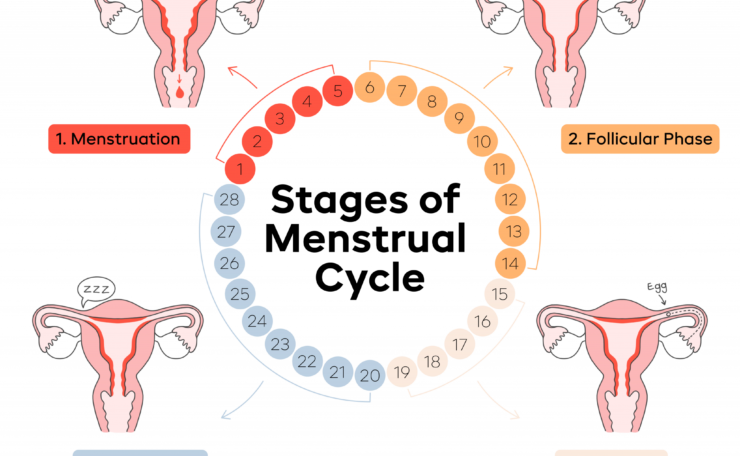Did You Know You Have Four Cycle Phases?
If you are tracking your period and ovulation, you can determine each phase of your cycle.
Menstrual Phase
These are the days when you are on your period (usually between 3 – 7 days)
Follicular Phase
This starts the day after your period ends up until ovulation
Ovulation Phase
Ovulation occurs within a 24 hour window (usually around mid-cycle). Your fertile window is the 5-7 days leading up to ovulation – this is when you can get pregnant
Luteal Phase
This is after ovulation occurs up until the day before your next period – this phase is the longest phase and usually lasts about 10 – 16 days
Supporting Each Phase:
Menstrual Phase: Replenish nutrients lost in the blood, manage or prevent  symptoms and nourish your body. Energy is the lowest now so focus on rest and gentle stretching.
symptoms and nourish your body. Energy is the lowest now so focus on rest and gentle stretching.
Follicular Phase: Support estrogen metabolism, health egg quality and rising energy levels. Energy levels will start to rise with your rising estrogen.
Ovulation Phase: Support higher energy levels, hormone detoxification and egg quality. You may feel more social and wanting to connect. Honor your higher energy levels!
Luteal Phase: This is the time of the month when those PMS symptoms start to show up – cramps, bloating, fatigue, acne. Focus on ways to support hormones, blood sugar, stress and foods to help prevent and manage symptoms.
To tune into your cyclical rhythm and what is happening in your body, you can start tracking different things throughout the month. This helps so you can:
- Connect with your body
- Understand your symptoms
- Incorporate foods, movement and other lifestyle shifts that align with how you are feeling
CYCLE PHASES – Your hormones fluctuate throughout your cycle and knowing where you are in your cycle is helpful to understand more about your mood and energy.
MOOD – Your mood can fluctuate with your hormones and can help you tap into potential hormone imbalances. Feeling super anxious mostly right before your period? Could be imbalances in estrogen and progesterone. Feeling super burned out? Could be something off with cortisol.
MOVEMENT – Your energy fluctuates with your hormones and it can be helpful to align movement with your cycle phases.
OVULATION – The main event of your cycle – you will always get your period 10 – 16 days after you ovulate. You can track this with a basal body temp, checking cervical fluid and using ovulation predictor strips.
MOON PHASES – The moon has a 28 day cycle just like we do and it can be fun to check in with where our cycle aligns with the moon.
SLEEP – Start tracking and notice sleep issues – do they always seem to fall at a certain of the month? This can be a clue into something going on with your hormones.
STRESS – Can affect all of our sex hormones and also can delay ovulation which can explain a late or missing period.
DIGESTION – Can be impacted by hormonal changes.
SYMPTOMS – Jot down the symptoms you experience and start to notice where in your cycle they fall. Symptoms are the language of your body and speak to you to communicate something may be off.
Healing body imbalances is not always as simple as doing 1 – 2 – 3 and you are good. Track your cycle for 3 months and see where the patterns are. Reach out for help with figuring out what each phase is saying to you. For help with charting and working with the phases of your cycle, let’s set up a complimentary discovery call to start to figure out your hormonal patterns and how to support your cycle during each unique phase.
I look forward to chatting with you!





